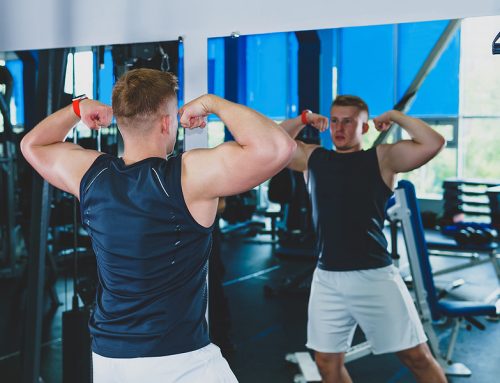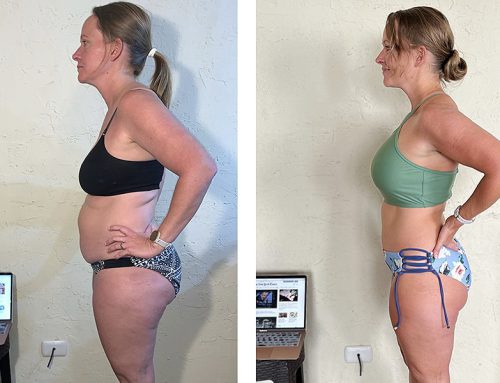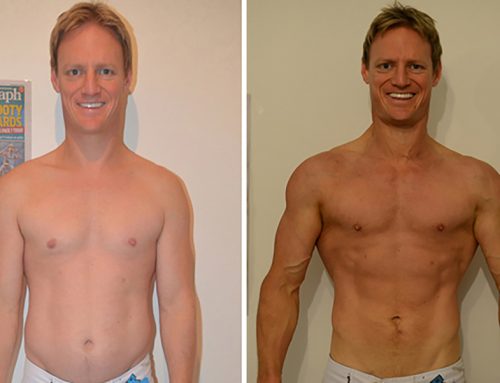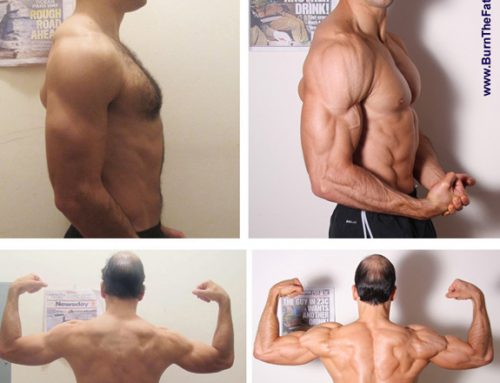Can you gain muscle and lose fat at the same time? That’s right up there with “How do I get six pack abs” as one of the most frequently asked fitness questions of all time. The problem is, when you ask it, you get all kinds of conflicting answers – even from experts who are supposed to know these things. So what’s the deal? Is it really possible to lose fat and build muscle simultaneously?
Short answer: Yes it’s possible to gain muscle and lose fat at the same time.
Long answer: It’s difficult and it’s complicated. Allow me to explain…
First we have the issue of whether you really lose fat and gain muscle at the “same time.”
Well, yes, if your definition of the “same time” is say, a month or 12 weeks. But in that case, you’re probably not gaining muscle at the “same time” literally speaking, as in, right now this very moment you are reading this, or 7 days a week, 24 hours a day for months in a row.
The best explanation for what’s really happening is that you alternate between periods of caloric surplus (anabolism) and caloric deficit (catabolism) and the net result is a gain in muscle and a loss in body fat.
You see, if you stay in a calorie surplus, it’s the body’s natural tendency for body fat and lean body mass to go up together.
And if you stay in a calorie deficit, it’s your body’s natural tendency for body fat and lean body mass to go down together.
There may be exceptions, but the general rule is that it is usually very difficult to gain muscle and lose fat at the same time – the mechanisms are mostly antagonistic to one another. When big increases in muscle and big decreases in fat are seen at the same time, it’s almost always the result of “unusual conditions” – I call them X factors.
The 4 X-Factors
The first X-factor is “training age” . Ever hear of “newbie gains?” The less trained your body is and the further you are from your genetic potential, the easier it is to gain muscle. The reverse is also true – an advanced bodybuilder with 20 years experience would be thrilled just to gain a few pounds of solid dry muscle in a year!
The second x factor is muscle memory. It’s easier to regain muscle you’ve lost than it is to gain new muscle in the first place (ergo, the fat out of shape semi retired bodybuilder who starts training again and blows up and gets ripped “overnight”).
The third X factor is genetics (or somatotype). Ever heard of the “genetic freak?” That’s the dude who sprouts muscle like weeds even when he’s on the “50-50 diet” (50% McDonald’s and 50% pizza)… and he never gets fat. (That dude chose the right parents!)
The fourth X factor is drugs. It would stun (or sadden) you if you knew how many people take performance and physique-enhancing drugs. I’m not just talking about pro bodybuilders, I’m talking about “Joe six pack” in the gym – not to mention those fitness models you idolize in the magazines. How did some of them get large muscle gains with concurrent fat loss? Chemicals.
I’m not a gambling man, but I’ll place a wager on this any day: I’ll bet that in 99% of the cases of large muscle gains with concurrent large fat losses, one or more of these x factors were present.
That’s not all! There are actually 5 more X factors related to your body composition and diet status (the X2 factors). I talk about those in my new program that’s going to be released on September 28th. More on that later.
So you’re not a beginner, you don’t take roids, you’re not a genetic freak and you have no muscle memory to take advantage of. Are you S.O.L? Well, I do want you to be realistic about your goals, but…
There IS a way for the average person to gain muscle and lose fat at the same time.
The Secret: You have to change your “temporal perspective!”
Traditionally nutritionists and fitness pros have only looked at calorie balance in terms of 24 hour periods. At midnight, you could tally up the calories like a shopkeeper closing out his register, and if the balance were positive, you’d say you were in a surplus for the day. If the balance were negative, you’d say you were in a deficit for the day.
But it’s entirely possible that you might pass through periods of “within-day” surplus where you were in a highly anabolic state (for example, you eat the biggest, highest carb meal of the day after your workout), and you were in a deficit the rest of the day.
Furthermore, exercise changes everything. certain types of training will alter your hormones and physiological response to how you handle calories and nutrients.
If you did intense weight training, and you timed your nutrient intake just right, isn’t it possible that you could gain a small amount of muscle during those anabolic hours, while losing fat the rest of the day? Granted it might only be grams or ounces – but what if you kept that up for a week? A month? Three months?
As you pan out and look at the bigger picture, what if most days of the week you were in a deficit for the entire day, and on some days of the week you were in a surplus? If so, then isn’t it possible that over the course of the week, you’d have a small net gain of muscle and loss of body fat as a result of the caloric fluctuation?
These within-day and within-week phases are what I refer to in my new book as nutritional microcycles and mesocycles. If you also had a primary goal with a longer term focus of several months, say 12 weeks or 16 weeks, that would be a nutritional macrocycle.
What I’ve just described is nutritional periodization. Some people call it cyclical dieting. It’s where you manipulate your calories (primarily by fluctuating carbohydrate intake, hence “carb cycling”) in order to intentionally zig zag your way through periods of surplus and deficit.
The end result: muscle gain and fat loss during the same time period!
I know that someone out there is having a hissy fit because I’ve only talked about calories: deficits and surpluses. Rightfully so. Calories matter but there’s more to it than calories – most importantly, hormones and “nutrient partitioning.”
If you’re in a calorie deficit you are going to pull energy from your body.The question is: From WHERE? If your hormones are out of whack because you’re eating crap and you’re living an unhealthy lifestyle, you could lose more muscle than fat in a deficit and gain almost pure fat, not muscle, in a surplus!
But WHAT IF you could manipulate within day energy balance, use nutritional periodization AND control your hormones with food and lifestyle strategies?
NOW we are seeing how concurrent muscle gain and fat loss are starting to look possible!
Make no mistake – concurrent muscle gain and fat loss is a difficult goal to achieve. It’s the “Holy Grail of Fitness Goals.” The good news: difficult does not mean impossible. Or as George Santayana said, “The difficult is that which can be done immediately, the impossible, that which takes a little longer.”
If you’d like to learn more about losing fat and gaining muscle at the same time, I just recorded a fantastic introduction to the subject in a one hour interview and you can have it for free as a gift because I want to get the word out about my newest ebook, The Holy Grail Body Transformation System. which is coming out later this month (September 28th.
In my new book, you’ll hear all the details about nutritional periodization, cyclical dieting, hormonal manipulation, within day energy balance, nutrient partitioning, AND the all the X factors, including the 5 “X2-Factors” – which are the keys to gaining muscle and losing fat at the same time.
You’ll also get my new “TNB” training system, which was originally published as a workout in Men’s Fitness magazine. Then I expanded it into a total program that has never been seen before except in my member’s-only inner circle.
My new free report that you can download now in MP3 and PDF (transcript) is available for a limited time this week over at my Holy Grail website. It’s a great introduction to the program and you’ll pick up some great tips just from this free report alone.
Download your Free “Holy Grail Body Transformation Revealed” report at:
www.HolyGrailBodyTransformation.com
Good luck in your “quest for the grail!”
-Tom Venuto
PS. If you have any questions about my blog post above, feel welcome to drop a comment below. If you have any questions after you download and read (or listen to) my Holy Grail Revealed interview, you can post those questions specifically on the new Holy Grail blog – you’ll get the link to that site after you get the download here:www.HolyGrailBodyTransformation.com
– Tom Venuto






Hi, Tom!It’s one of the things I respect you for – the no-drug policy.On the fourth X factor I’d like to tell you that a couple of months ago I addressed a very popular female bodybuilder as to whether her muscles were natural and she said ‘Natural? Do you see anything natural in the way I look?’ Needless to say, I dropped any interest in her and her allegedly natural nutritional program.I say, if it can’t be done naturally, I ain’t doing it :)Thanks for the free “Holy Grail” report!
I’ve been thinking about this topic for a long time.I agree with your x-factors, but I don’t think it applies to 99% of people who achieve the ‘Holy Grail’. Look at all your challengers, they manage to achieve great results in LBM and in Fat Loss.I’ve managed to achieve the ‘Holy Grail’ for both of your challenges Tom. Outside of the challenges, it’s a slightly different story.The biggest difference between the way I train during a challenge and outside of one, is my cardio. I do much more cardio during a challenge. So I think the nutritional partitioning definitely plays a role!It makes sense to me that higher intensity cardio would target larger muscle fibers. I predominantly do high-intensity cardio. Never fasted.I lift 5 days a week during both times, and I think weight lifting also definitely plays a role in persevering / growing muscle when on a calorie deficit.The other difference is creatine. This inflates the LBM figure with water… mimicking ‘Holy Grail’ results. Personally, I find creatine does very little for me. My weight hardly fluctuates going on or off it (doing a proper loading phase).I also agree that nutrient timing is essential. Protecting the muscle when it’s a the most risk of being burnt up. That being in the morning and around your workout.Lastly, I think having a very moderate deficit can help. I just think that the body is less likely to get rid of energy expensive muscle if there isn’t too much a threat of starvation.My humble opinion on the very interesting matter :)-Ryan(waceman)
ryan, thanks for your post.I agree on all points, although if you take the HG approach and choose a primary objective, when primary objective is muscle gain first, fat loss second, i lean toward more conservative on cardio, but ALWAYS keeping the cardio in there. Primary objective fat loss, secondary muscle gain, then more cardio, increasing cautiously. primary objective focused fat loss: much more cardio; even daily,I also agree, regarding challenges, that….Simply put, you always, always, always, get in the best shape of your life under the positive pressure of a contest -and it doesn’t have to be an on-stage body building or figure contest – transformation contest have similar motivation factor.i agree, the results from this last burn the fat challenge re the body recomposition were insane! It has actually changed my thinking even more.But… people have to enter these contest or some type of challenge with clear cut goals, accountability, support, rewards and motivation to reap the benefit.Its a lot harder to do on your own with no goal or “challenge.”thanks againTomPS you took the cutting to another level yourself this time…
HI Tom. For what it’s worth i never doubted you. I gain muscle while trimming up all the time. I don’t gain a lot of it but i do gain some. i know thins because i keep a carefull eye on my strength.When i’m cutting i eat a lot of protien while keeping my calories about 500 below my maintance calories. I eat some carbs with protien before and after training as well as taking whey protien. On my non training days i keep the carbs a little lower. And i take casien protien before bed and at one other time about mid day.The result is that even when cutting my strength keeps increasing, all be it at a much slower pace. But hey it works for me so i can only assume it works for others as well.
hi Tom,I have been working on this “Holy Grail” approach somewhat by default since last Dec, when I decided I was willing to invest more time and attention to lifestyle work, in order to keep and develop my muscle. I kept thinking about what I wanted to look like after the fat was reduced. I was also thinking about how I wanted to feel (namely stronger). I had focused just primarily on “fat loss” for many months and that was a good thing when I had so much extra fat, but as I began to lean down I wanted to be able to keep and gain some muscle and strength. That is when I decided that no matter how long it took (I shifted my focus off of time) I would focus on the results I really wanted. (not just losing fat!)I have experiemented with all sorts of calorie cycling and relied on my body’s intelligence to guide me. Honeslty there have been times when I felt like I could literally eat a horse and had tremendous challenges with food cravings. But an interesting thing has happened recently. As I have given my body time to adjust to lower calorie needs (intakes) (nothing extreme) but rather cycling deficits with moderate surpluses, my body has started to respond. To me one of the overall benefits of the Holy Grail approach is that while it may seem more diffiucult or complex, it promotes a longer term, “lifestyle” approach. Maybe the difficulty some have in accepting this is that it does require more time, patience and committment to overall health. NOT JUST GETTING RAPID FAT LOSS RESULTS! It is great when that happens, but there is a time for the body to find its own rythyms of balance. Being strong, lean and healthy is the natural state that my body, mind gravitate towards. My challenge is to work with that process. The Holy Grail lays a solid foundation for doing body work that promotes long term results. This Holy Grail techniques is what I will continue to use long term, because I know it does work, if people give it a fair chance.Thanks for all your hard work Tom!Your friendScott
Great article, Tom – love your work. We teach holistic/whole foods nutrition coaching & work with Berardi who does as well & is on our advisory board. Love learning from both your work & that you both impart the possibilities of advanced natural nutrition program design & hard work vs. synthetics in our industry of body transformation. Looking forward to reading more about your latest work.
Hi TomI like the no-drug policy I am presently 14 kg over my ideal weight. Been trying hard to eat right but have not have alot of time to do my work out weekly.Is it true that we need to loss the fat 1st before we build our muscleAppreciate your advise
Hey Tom,Love the post. I think you’re absolutely right on here. I had newbie gains when I first started lifting, but have had to get more specific with my eating as I’ve progressed.For me, I don’t train (with weights) daily, so on days I have done my weight training, I put myself into a calorie overload and stay in deficit most of the rest of the week. The results so far have been great.I can’t wait to see what all you have in store for us in this new program.Talk soon,Ryan
I am amazed that it seems to be such a big deal! There are so called experts who would say it can’t be done and yet many of us have done it, myself included! You can lose body fat and gain muscle at the same time! After I lost weight and got down to about 180 pounds, I still had over 30% bf, and now I have kept that weight and got my bf down at times below 14%, which is not bad for a 57 year old guy! The short of it is you can indeed lose body fat and gain muscle at the same time. I had done it!
Tom, great stuff you put out.A thought on long term goals on maintenance. An approach I sometimes use, when motivation drops, is to just eat calories at a level my body tells me to, so I feel satiated but not full. No calorie counting or worries. At times I’ll gain muscle and lose fat, but neither well, sometimes I’ll gain muscle with a little fat, sometimes I’ll lose fat and keep muscle. As long as I’m exercising and eating well, my body responds in positive ways and doesn’t go into starvation mode. Goals are important (e.g., ripped, bulk, strength) but moot if reaching them is a process that discourages long-term consistency.Looking forward to reading the new publication! -Jim
I don’t only believe this is true, I KNOW it is true.This has happened for me, often while being on just above maintenance calories while lifting heavy (as always) and doing a lot of cardio.I am a huge believer in having a protein hit straight after a workout, having a shower and stretch and then having a big meal afterward with healthy lean proteins and always a good serve of low GI vegetables.I believe this to be a big factor in what you said above about being able to gain muscle for a small time during the day and then be losing fat the rest of the time.I guess it also depends on when you do your workouts, for me I love doing them in the morning for a whole mountain of reasons.It is sad that so many people resort to dangerous, illegal and potentially fatal drugs just for a few pounds of extra flesh on their body.Thanks Tom for your post, as usual, always solid information.Johnny
I hate it when people say you can’t gain muscle and lose fat at the same time. Gaining muscle mass is wonderful because it increases your metabolic rate (thus helping to burn fat).
Hi Tom,My goal is to gain muscle and lose fat at the same time. I have been working out and have seen some muscle gain but I still have lower belly fat I am having trouble getting rid of what would be my best options in your opinion. I am 5’9″ and about 177 overall fat is not too bad mostly belly and upper body area.